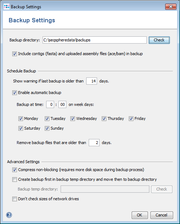Contents
Creating Database Backups
The SeqSphere+ server creates database backups periodically. By default, the database backups will be created each day at 00:00 in the subdirectory backups of the working directory. The backup process has a blocking part, where users cannot login or work on the server because the database is locked.
To change the backup settings login as Administrator user, and invoke the menu item ![]() Administration | Server System Administration.
Then use the button Edit Server Backup Settings to show Backup Settings window. The following options can be specified.
Administration | Server System Administration.
Then use the button Edit Server Backup Settings to show Backup Settings window. The following options can be specified.
- Backup directory
- The backup directory defines the location where the backup file should be stored.
- It is highly recommended to put the backup directory on a hard disk other than the database directory! For performance reasons, an internal hard disk is ideally.
- Show warning if last backup is older than ... days
- If no backup was successfully performed in the period, a warning is shown in the SeqSphere+ client when a user logs in. The default is 14 days.
- A warning is always shown if the last backup has failed.
- Enable automatic backup
- Define the time (24h format) and week days when the backup process should be started.
- Remove backup files that are older than ... days
- Remove automatically all backup files that are older than the given number of days. The deletion is performed after a backup process has successfully finished. If the current backup process fails, no files are deleted. The default is 2 days.
- Compress non-blocking
- If this option is enabled, the compressing (zip) of the backup file is done after the database backup command has finished. Therefore the blocking time of the database is much shorter, however, this requires more disk space during the backup process. This option is enabled by default and it is strongly recommended to leave it enabled to reduce the blocking time.
- Create backup first in backup temp directory and move then to backup directory
- If the backup directory is located on a network device (e.g., NAS) and/or to save some space in the backup directory, this option should be enabled to create the backup first in the backup temp directory. By default the temp directory of the system is used. If there is not enough free disk space in the system temp directory, a different backup temp directory on another local disk must be configured here.
- Don't check sizes of network drives
- By default, the sizes of the available disk space for backups is checked before the backup is created, and too low disk space is reported to the SeqSphere+ users. However, there are network drive environments where the size check can fail, and false disk space error reports. If this happens, the size check for network drives can be disabled here.
See more details on disk storage required for the database and backups.
A backup process with the current settings can be directly invoked using the button ![]() Do Server Backup now.
Do Server Backup now.
Restoring Database Backups
Server installed on Windows
- Exit the SeqSphere+ server
- Choose in the Windows Start menu Ridom SeqSphere Server | Server Database Restore Backup
- Choose a backup file from the backup directory
Server installed on Linux
Perform the following steps to restore the most recent backup:
- Exit the SeqSphere+ server
- Invoke the SeqSphere+ with command line parameter
-restoreLastBackup. The server restores the backup and exits automatically - Start the SeqSphere+ server again (without the command line parameter)
Alternatively, you can use the command line parameter
-restoreBackup <backup_file>
to choose a specific backup file.
Overwriting Existing Database
When a backup is restored, the existing database is overwritten. Therefore the backup restore process asks if the existing database should be deleted or moved to another directory. If the move option is chosen, the existing database is moved into a directory called old_database in the working directory. This directory is never removed automatically, and therefore it must be removed manually to save the disk space when it is not needed any more.
Manually Restoring the Database
It is highly recommended to use the software functions explained above to restore the update. However, it is technically also possible to restore the backup manually. Depending on the backup options that were configured there a two different file formats for the backup file: If the backup is a TGZ file, it only contains the four database files. For restoring, those files must be placed in the database directory of the server, replacing any existing files. If the backup is a ZIP file, it contains the two folders data and filestorage. For restoring, those folders must replace the database and filestorage directories of the server. The server must always be stopped before any database files or directories are replaced!


